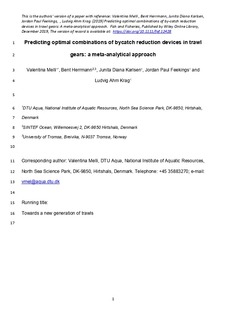| dc.description.abstract | Global efforts to reduce unwanted catches have led to the development of a vast array of by‐catch reduction devices (BRDs), in particular for mixed trawl fisheries. Some of these BRDs could likely benefit from being combined. However, the number of possible combinations would be prohibitive to be tested experimentally. Therefore, in this study we propose a meta‐analytical approach that combines the data available on BRDs tested independently in a fishery and predict the theoretical selectivity of all possible combinations of those devices. This allows to identify promising BRD combinations, worth experimental investigation and flexible trawl configurations, where the selectivity can be substantially modified by adding or removing one BRD, thus aiding fishermen in adapting to high variability in catch composition and quota availability. To illustrate the approach, we used BRDs developed for the well‐studied Nephrops (Nephrops norvegicus, Nephropidae) directed mixed trawl fishery in the Skagerrak and Kattegat seas. We predicted the selectivity of 100 BRD combinations for Nephrops, cod (Gadus morhua, Gadidae) and haddock (Melanogrammus aeglefinus, Gadidae), compared them in terms of absolute selectivity and performance under realistic catch scenarios, from both single‐ and multispecies perspectives, and identified 15 BRD combinations that could be worth future experimental investigation. The meta‐analytical approach makes best use of existing knowledge and leads to new insights about the potential for improvement and flexibility in trawl selectivity. This could benefit a variety of mixed trawl fisheries and help developing a new generation of more flexible gears, with multiple BRDs integrated in their structure. | nb_NO |

